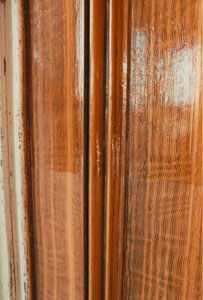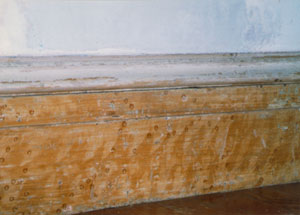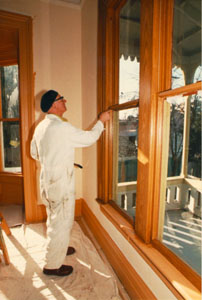

Much of the wood in the house is given a finish to resemble that of more expensive and desirable wood.
"Graining is a method of reproducing expensive woods through a painting and varnishing process. The main advantage of grained wood was its durability. The surface of wood painted in the 1860's was somewhat rough and caught dirt easily. The paint base being white lead would also oxidize and appear dirty. Painted surfaces required diligent cleaning by a house maid while the more durable grained surfaces only required wiping with a damp cloth to keep clean.
 The process of graining consists of a building up of several layers of paint and colour. A first layer or ground colour (an opaque paint) is laid down; for oak a pale greeny-cream colour is often used. Over that another coat, much darker in colour is applied
The process of graining consists of a building up of several layers of paint and colour. A first layer or ground colour (an opaque paint) is laid down; for oak a pale greeny-cream colour is often used. Over that another coat, much darker in colour is applied
'the colour being thicker than usual; this is then scratched over by combs of bone, with blunt points, and of various degrees of coarseness, leaving the ground visible. The cross white veins or champs are next taken out with the corners of a piece of soft leather doubled up. The next process, which in cheap work is omitted or carelessly done, is over-veining; this is effected with a wide flat brush, the hairs of which are long and slender, dipped in transparent colour, when...the cross veins of the wood are dexterously imitated with this tool and show the other veins below.' (Encyclopaedia of Architecture; Joseph Gwilt; 1867)
After, the whole was protected with one or more coats of (usually copal) varnish." (from "Interior Site Investigation of the Principal Rooms of the Richard Carr House" report by Stuart Stark)
The graining of wood was also a style recommended by Andrew Jackson Downing: "...we would strongly recommend that the wood-work be either grained, in imitation of these woods, or, in the cheapest cottages, stained, to have the same effect...
The great advantage which grained wood-work has over that which is simply painted...is, that it is so easily kept clean. ...Every one who has made a trial of grained or stained and varnished wood-work, will agree with us that it is great economy of time and labour in housekeeping, while the addition to the cost of plain painting is very trifling."
(Andrew Jackson Downing, The Architecture of Country Houses: Including Designs for Cottages, Farm Houses, and the Best Modes of Warming and Ventilating (1850) )
 Bird's Eye Maple skirting, as seen to the right is found in some rooms in the house. California redwood was used originally and the wood was grained similarly to oak, but small dark "bird's eyes" were added using a red-brown paint. Some of the bird's eye maple wood had to be replaced and were fashioned by a skilled craftsman who produced wood of the same quality as was used historically.
Bird's Eye Maple skirting, as seen to the right is found in some rooms in the house. California redwood was used originally and the wood was grained similarly to oak, but small dark "bird's eyes" were added using a red-brown paint. Some of the bird's eye maple wood had to be replaced and were fashioned by a skilled craftsman who produced wood of the same quality as was used historically.


One of the popular styles in Victoria's homes was to mix oak door frames with mahogany doors. An example is this door, to the left, on the second floor of Carr house. The wood has been given an oak and mahogany finish.
![]() Return to restoration main page.
Return to restoration main page.

 |
 |
 |
 |
 |
 |
| Gallery | Tour | Family | Writing | Issues | Team |